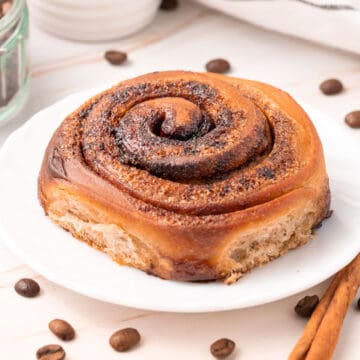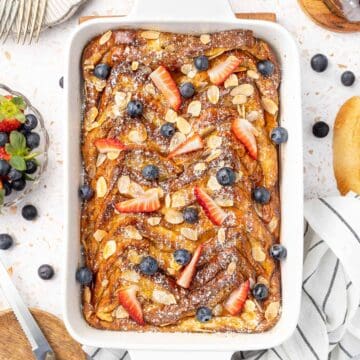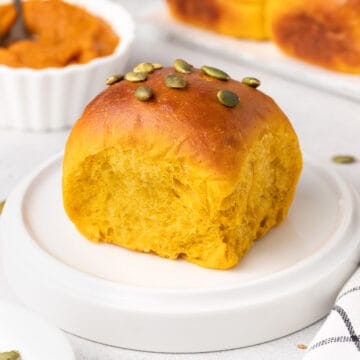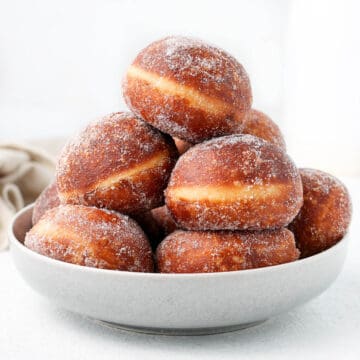This classic French Brioche Loaf Bread is deliciously rich, fluffy and buttery. Perfect for breakfast with butter or jam, to make French toast or enjoyed on its own as a sweet treat, you will never want to buy brioche bread again after tasting a homemade one!
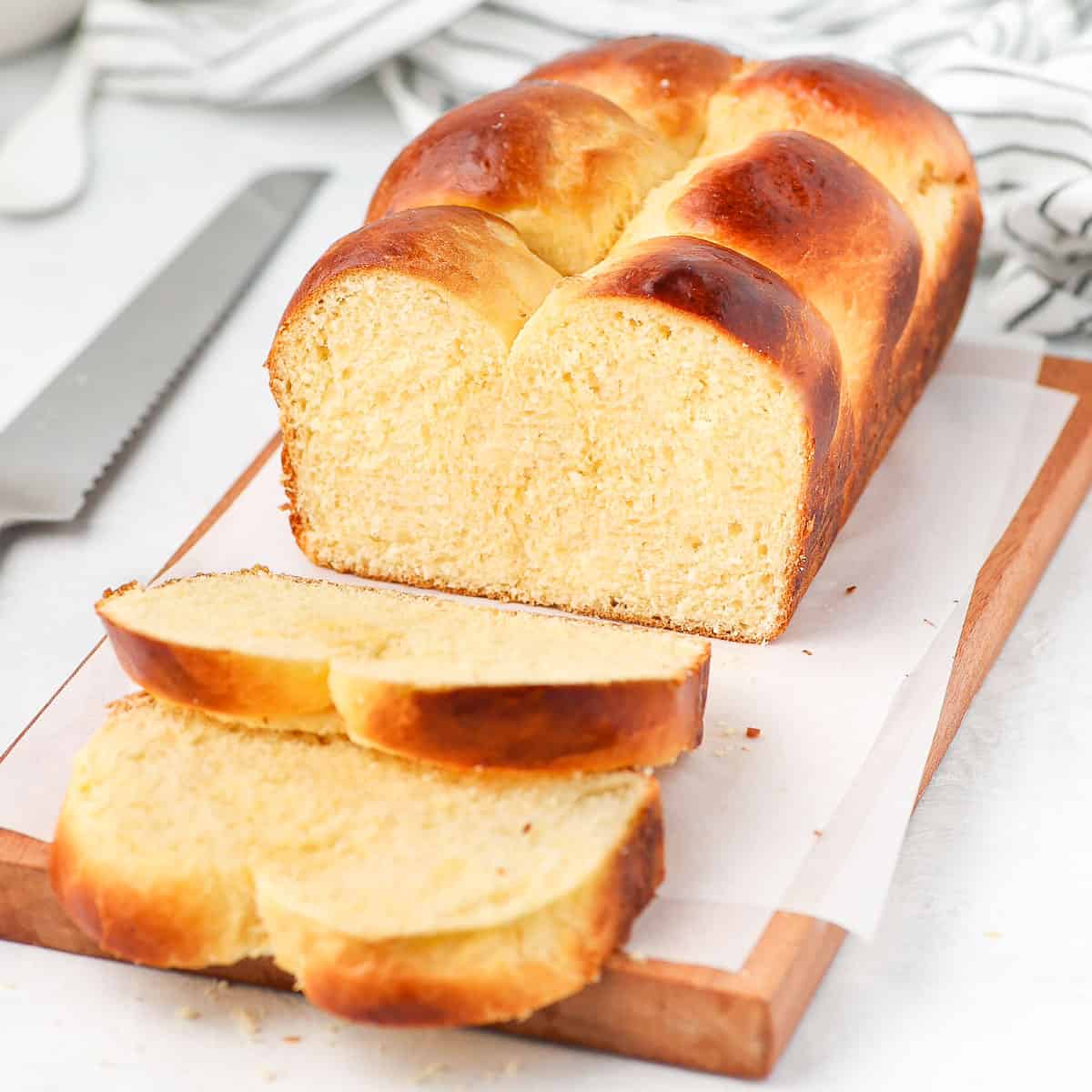
Jump to:
Why we love this recipe
Nothing beat the smell, flavour and texture of a homemade brioche bread loaf. A mix between a bread and a pâtisserie (called a Viennoiserie in French), this classic French pastry recipe make the most soft, fluffy, buttery and moorish sweet bread!
Made from basic staple ingredients, brioches are super versatile enriched breads that can be used to make toasts, sandwiches, Brioche French toast, Brioche Donuts, Brioche French Toast Casserole, Bread Pudding or simply be enjoyed on their own. You could even make buns for burgers or slider rolls using this recipe!
You can keep the loaf bread plain like here or use this recipe as a base for your fun creations like this Chocolate Chip Brioche or Chocolate Brioche Braid!
Ingredients
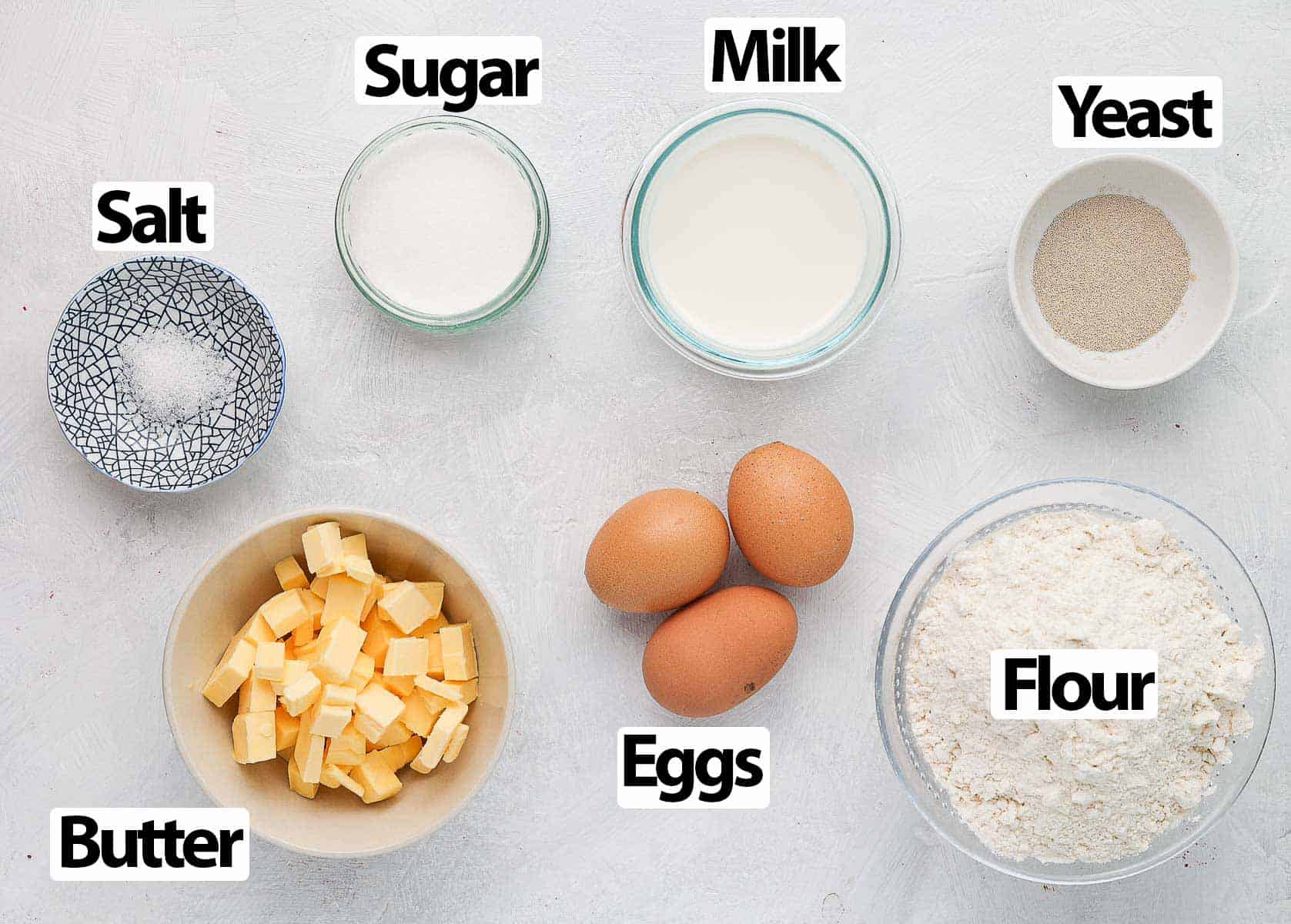
This basic brioche recipe requires 7 ingredients (Scroll down to recipe card for all quantities):
- Milk: use Full Cream / Whole Milk for the best flavours. It needs to be lukewarm (around 30 to 35 degree celsius) in order to activate the yeast and help the bread rise. Be careful not to heat up the milk too much or you risk killing the yeast.
- Yeast: I used Instant (dry) Yeast here. You can also use Active Dry Yeast but you want to make sure to properly bloom it in the warm milk first (rehydrate it in a liquid to activate it).
- Sugar: Caster Sugar or fine white granulated sugar. I have never tried this recipe with a liquid sweetener substitution.
- Eggs: medium size eggs, at room temperature (the temperature is very important here!). I personally like to whisk the eggs first in a separate bowl to help them incorporate easily into the dough, but that is optional. You will also need some egg for the egg wash that you brush over the loaf before baking it.
- Flour: Plain / All-Purpose Flour. One of the particularity of this type of enriched bread is that it is made with regular baking flour and not bread flour. This gives you a lighter, fluffier crumb.
- Salt: fine Table Salt - just a little bit to balance the sweetness of the bread.
- Butter: unsalted (do not use salted butter here) and at room temperature. It is very important for the butter to be soft or it won't incorporate into the dough easily. It also shouldn't be too warm or it will split when you knead it in.
Optional Additions
You could add many different ingredients to the basic brioche dough to customise it like I did with chocolate chips in my Chocolate Chip Brioche recipe, with jam and chocolate like these Chocolate Raspberry Swirl Brioche Buns or laminated with a chocolate filling like this Chocolate Brioche Bread recipe.
You could also add some fried fruits like Raisins or chopped Dried Apricot, use some Orange Zest or even some Orange Blossom Water!
How to make French Brioche Bread
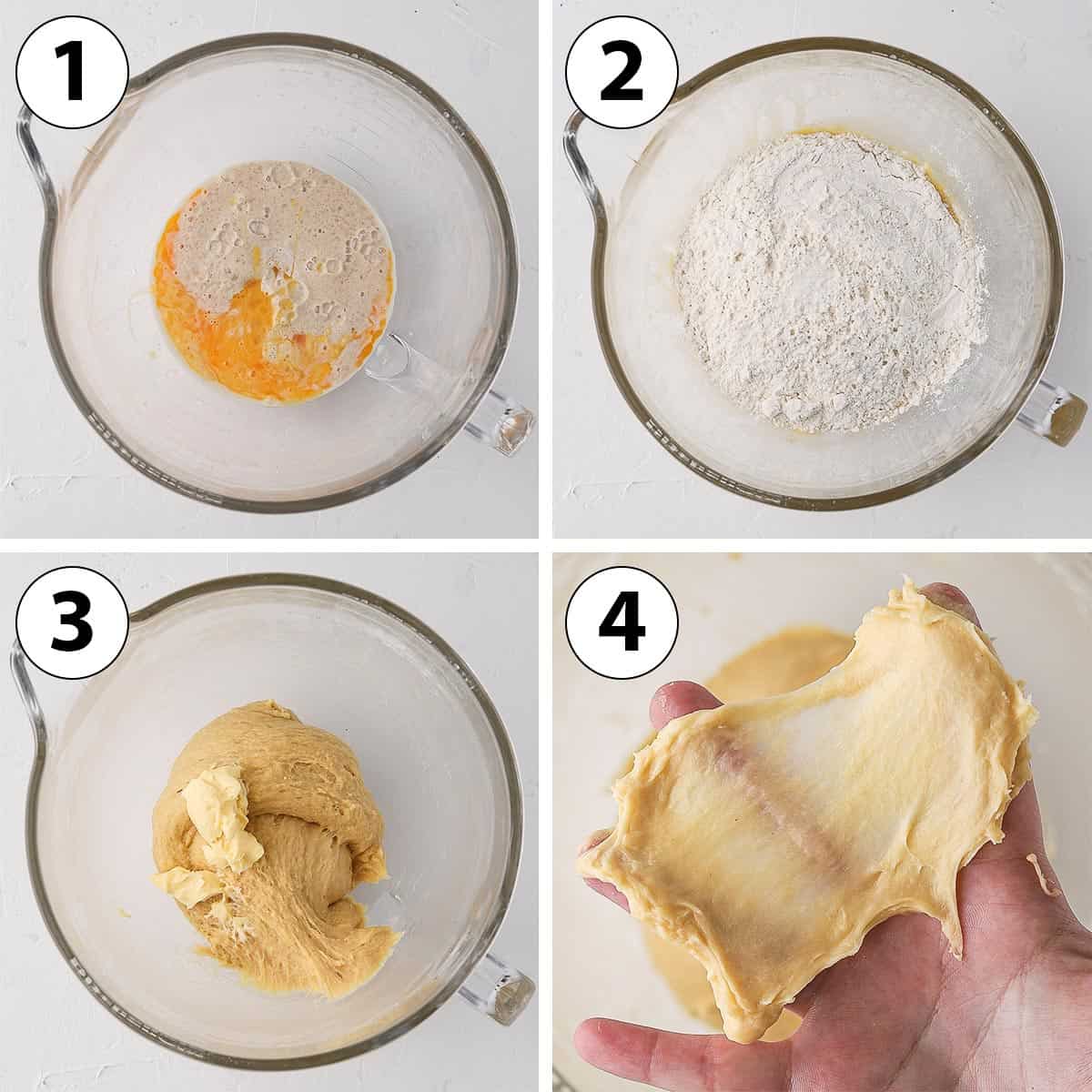
Making the brioche dough
To make a traditional Brioche loaf, either start at night (to bake the next morning) or early morning (to bake at night) following these instructions:
- Place the Lukewarm Milk, half of the Sugar and Yeast in the bowl of your stand mixer. Mix to combine then let it sit for about 10 minutes or until small bubbles/froth appears on the surface (this is to check that the yeast is alive before making the bread).
Make sure the milk is not too hot or it will kill the yeast. It should be at around 30 to 35' celsius (85 to 95' F); if you touch it with your finger you shouldn't feel its warmth. Also note that "blooming" the yeast (what we are doing here) is not technically required when using Dry Yeast but it is mandatory if using instant yeast.
- Photo 1: Add the room temperature Eggs, preferably pre-whisked.
- Photo 2: Mix in the rest of the Sugar, the Flour and lastly the Salt (it needs to be added last to not come in direct contact with the yeast as salt can kill the yeast). Fit your mixer with the dough hook attachment and knead on medium speed for about 5 minutes or until a rough dough comes together.
- Photo 3: Add the soft unsalted Butter to the mixture, a little bit at the time. Knead on low speed (to medium low) until the butter is fully incorporated before adding more. Stop and scrap the sides of the bowl if required.
If you add too much butter at once, the dough will struggle to incorporate it and it will turn quite greasy. Make sure to slowly add it to get the perfect smooth dough!
Photo 4: Knead on medium to high speed for about 15 to 20 minutes or until the dough is very soft, stretchy and passes the "windowpane test" (see tips section below). You should get a lightly sticky dough that is very smooth.
If it feels like the dough isn't coming together, you can let the dough rest for 10 to 15 minutes then continue to knead.
This brioche bread does require a long kneading - much longer than most breads. That is because the dough is enriched with lots of fat (butter, eggs and milk) which slows down the gluten formation and development. Do not skip this long kneading step to get the perfectly fluffy brioche - it needs to be well kneaded!
- Cover the bowl with a tea towel or plastic wrap and place in the fridge to proof overnight (or all day if making in the morning). It will need about 8 to 12 hours in the fridge to double in size, but you could keep it refrigerated for about 24 hours too.
You can also proof the dough in a different lightly greased bowl if preferred, but I usually just use the bowl of my mixer. The dough contains enough fat not to stick to the bowl.
You could proof the dough at room temperature for a quicker recipe (about 1,5 hours of proofing in a warm spot), but the dough will be harder to handle (more sticky and soft) and won't have as much flavour.
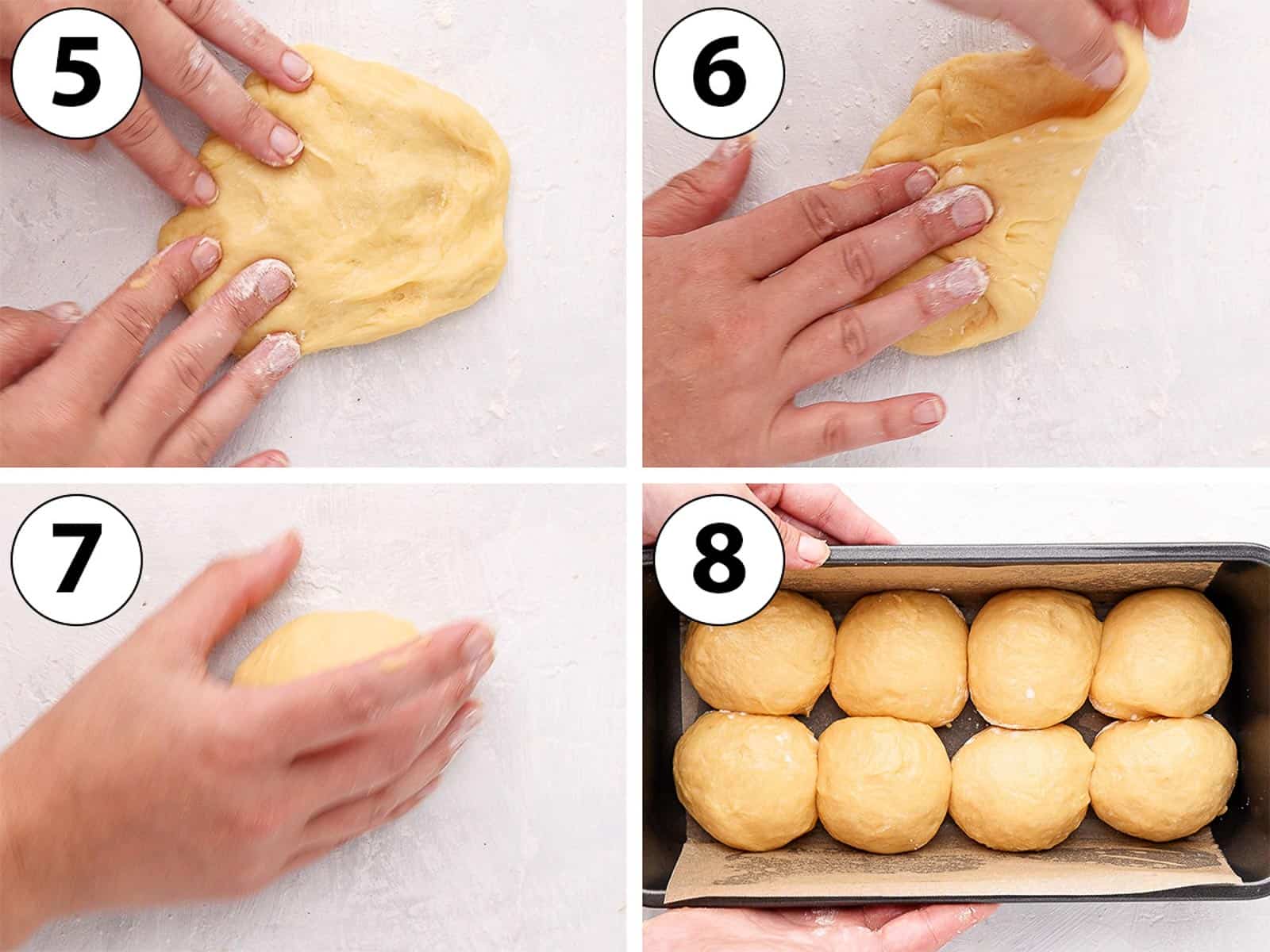
Shaping the loaf
You can refer to the video in the recipe card below to see how I shaped the brioche loaf bread.
- Once the dough has doubled in size, take it out of the fridge and punch out the air. Transfer over a lightly floured work surface and cut into 8 equal portions. Set aside.
I used a scale to be more precise: I measure the full dough, then divided that in 8 to get the right weight of each brioche bun.
- Photo 5: flatten each piece of dough with your fingers.
- Photo 6: Pull the edges of the dough and fold them towards the centre. Gently press on it so that it stick. You should get a round, bun shape. Turn the dough over, seams down.
- Photo 7: Shape the dough into a bun by gently pull it towards you, your fingers placed on one side / bottom of the roll. Turn it 90 degrees and repeat until you feel tension on the dough (it shouldn't feel as soft as at the start). Continue to shape the dough into a bun by rolling it in a circular movement under the palm or your hands.
You do not want to over-flour the surface you are working on for this step. Having the dough slightly sticking the surface will help you create tension within the dough.
- Repeat the process with all the dough pieces.
- Photo 8: Place the buns in a Loaf Pan that has been lightly greased and lined with baking paper. I placed the buns in 4 rows of 4, having 2 buns side by side.
I used a 14 x 28 cm Loaf Pan (5.5 x 11 inch).
- Lightly whisk an egg in a small bowl and brush it over the buns to give it a golden brown colour when they bake. Cover the Loaf Pan with a kitchen towel or plastic wrap and let it proof at room temperature for about 1 to 1,5 hour, or until the buns have doubled in size again.
- Bake in the oven preheated on 180'C / 350'F for about 25 minutes, or until puffed and golden. Let the brioche loaf cool down for about an hour before removing from the pan and placing on a wire rack to finish cooling. It is important not to cut the brioche when slice warm or it will turn dry.
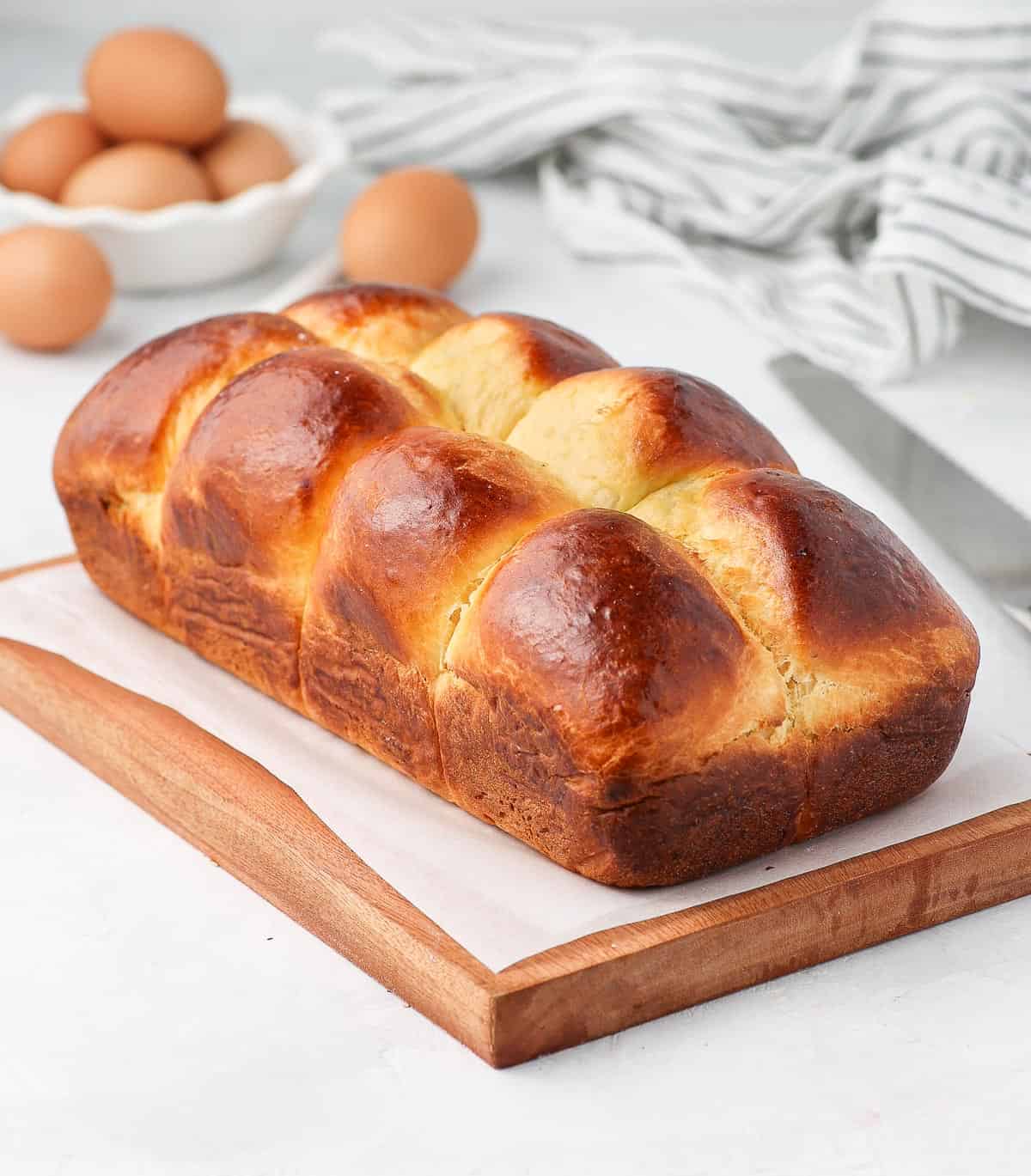
Recipe FAQs
A Brioche is a classic French sweet bread that has a fluffy, tender and sweet crumb. It contains a high ratio of eggs and a lot of butter that give the bread a tender crumb and deep flavour. It is part of a group of food called "viennoiseries", along with croissants, pain au chocolat and other items that are considered to be a mix between a pastry and a bread.
How is brioche bread different than other breads? The main difference is that brioche is an "enriched dough", which means that it is enriched with fats like eggs and butter (or oil like for Challah Rolls). It is also sweetened with sugar.
Yes, although the crumb won't be as soft and tender with bread flour.
You could, but I would not recommend it. Brioche dough requires a rather long kneading time (20 to 30 minutes) and is a very soft and sticky though, making it quite hard to work with by hands. Using a stand mixer will give you the best results.
Yes, but keep it mind that proofing the dough at room temperature (until doubled in size - about 1,5 hours) will make it much harder to work with because it will be very soft and slightly sticky. Proofing it in the fridge does not only make the dough much easier to work with, it also helps it develop a lot more flavours.
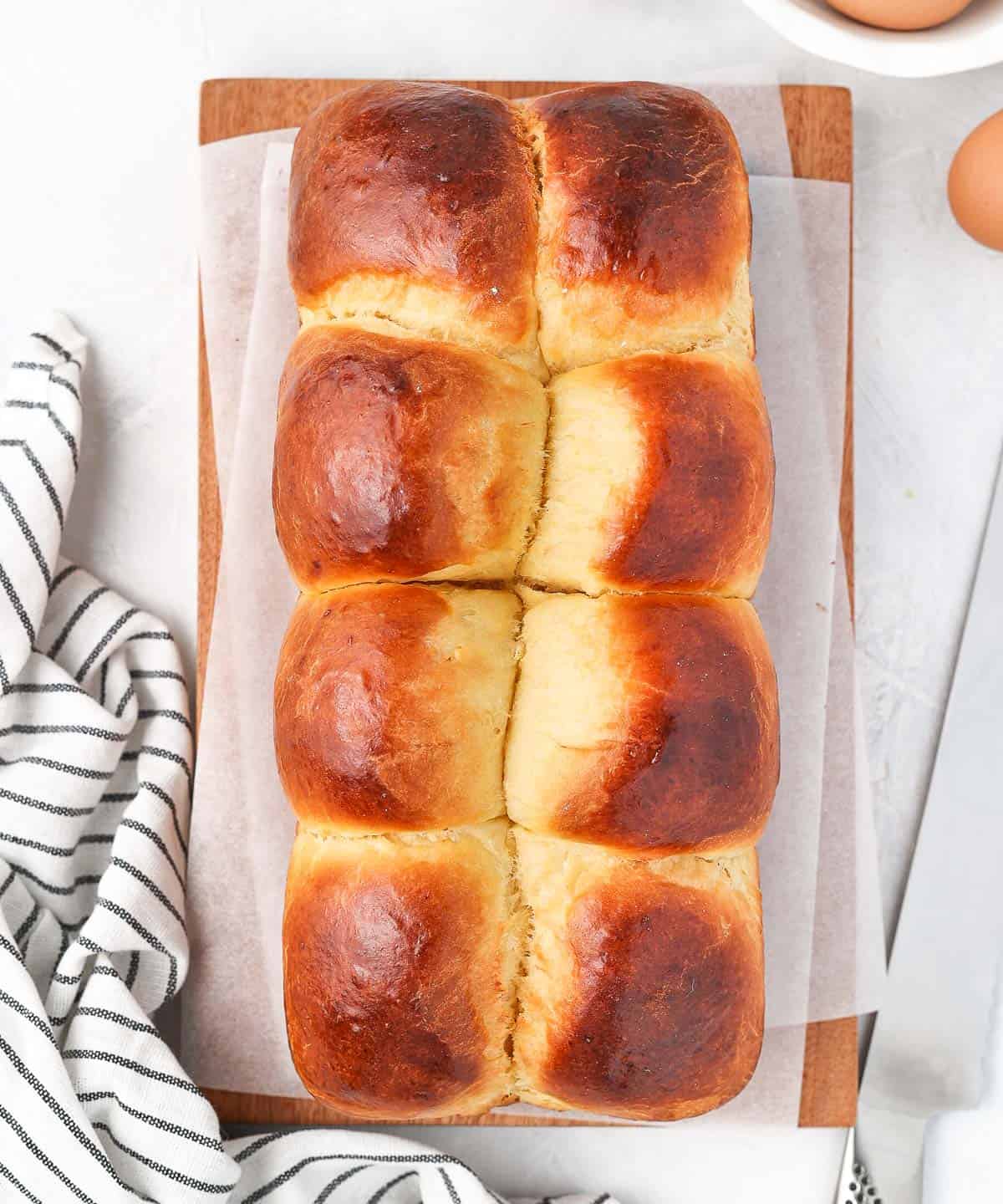
Troubleshooting
- The dough is really sticky
Keep kneading it. It takes quite a long time for the dough to come together (much longer than regular bread). Try not to add extra flour as the dough does not need it. As the dough chill in the fridge, it will harden a bit and be easier to work with.
- The brioche dough didn't rise
Check that your yeast is still alive or make sure that you left if proof for long enough. The cold fermentation will make the bread rise much slower than at room temperature, so it is possible that your dough simply needs more time for proofing.
- The bread is hard / not as soft after a day:
Unfortunately, brioche is best eaten fresh. Because it contains so much butter, it tends to dry out rather quickly when left exposed at room temperature. You can freeze individual slices for later to keep it fresh too!
- How to know the dough has been kneaded enough?
Do the "windowpane test" by gently pulling and stretching a small piece of dough. If the dough breaks quickly, it needs to be kneaded for longer. If it stretches easily without breaking and you can see light coming through it, it has passed the windowpane test.
- How to know that the brioche is ready to be baked?
To know that the bread dough has proofed for the right amount of time, gently poke it with a finger. It should leave a small indentation that slowly springs back halfway. If the indentation springs back straight away, it is under-proofed. If the whole dough deflates, it is over-proofed.
How to eat Brioche
My personal favourite way to serve brioche bread is toasted with jam (or any of your preferred spread like Lemon Curd). It can also be eaten plain as a sweet snack.
Brioche can also be used to make the most delicious Brioche French Toast ("pain-perdu") - either classic or french toast bake / casserole, to make bread and butter Pudding or even croutons and stuffing!
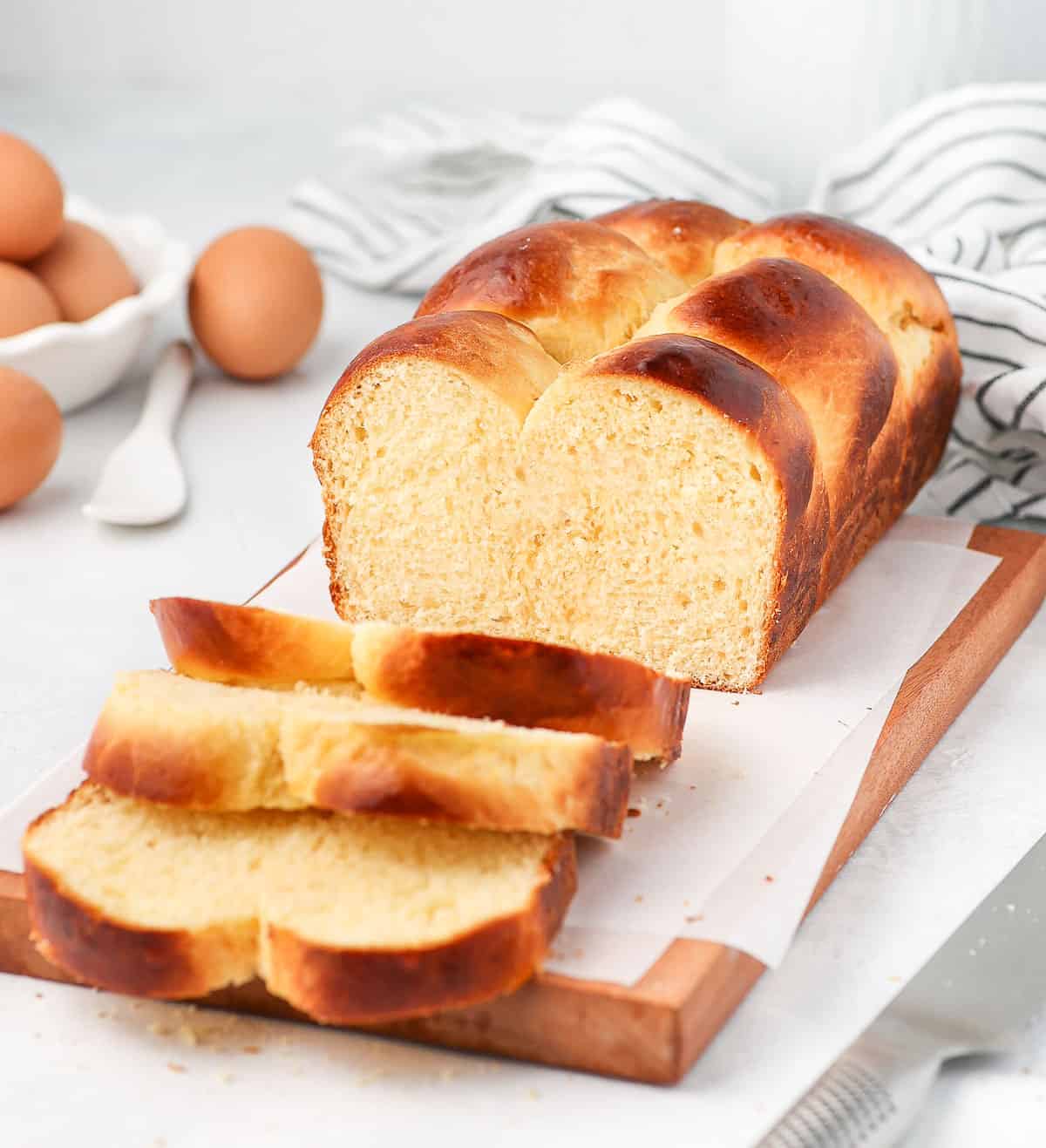
Tips for Success
- Add the butter a little bit at the time - and at the right temperature. If the butter is too warm, it will struggle to incorporated in the dough and you will notice the dough is very greasy. Place the bowl in the fridge for 5 minutes then keep kneading. If the dough is too cold, you will notice chunks of unmixed butter in the dough. Place the butter for a few seconds in the microwave or leave at room temperature for a bit longer.
- Knead for at least 20 minutes after all the butter has been added. Yes, it is a long time (much longer than for most doughs), but it is the best way to insure a good gluten development that will result in a super light and fluffy crumb!
- Proof overnight for a bread that has a delicious, deep buttery flavour and a dough that is easy to work with.
- How to shape a brioche loaf is up to you. I used 8 buns combined into a loaf, but you could also:
- cut the dough into three, roll each piece into a log and braid them.
- shape it as a "Nantaise Brioche" where the rolls are placed in a zigzag pattern in the loaf pan to create the impression of a braid (without braiding it).
- bake in individual portion (if making hamburger buns for example). Just make sure to bake them in the oven for less time.
- rolled with a rolling pin into a rectangle, then rolled on itself (log shape) and placed in a loaf pan. This will resemble more of a sandwich loaf bread.
Storing & Freezing
Brioche is best eaten fresh, within a couple of days.
Should you refrigerate brioche? I recommend keeping it at room temperature, either in the loaf pan covered or in a container. Although placing the loaf in the fridge will make it last for much longer, it will also make the butter harden and the crumb will turn hard.
Brioche dough also freezes quite well - and freezing brioche is a great way to keep it fresh for much longer! You can either freeze the whole loaf, or slice it and freeze it into individual slices (each separated with baking paper so that they don't stick together). Leave to thaw at room temperature or toast to thaw.
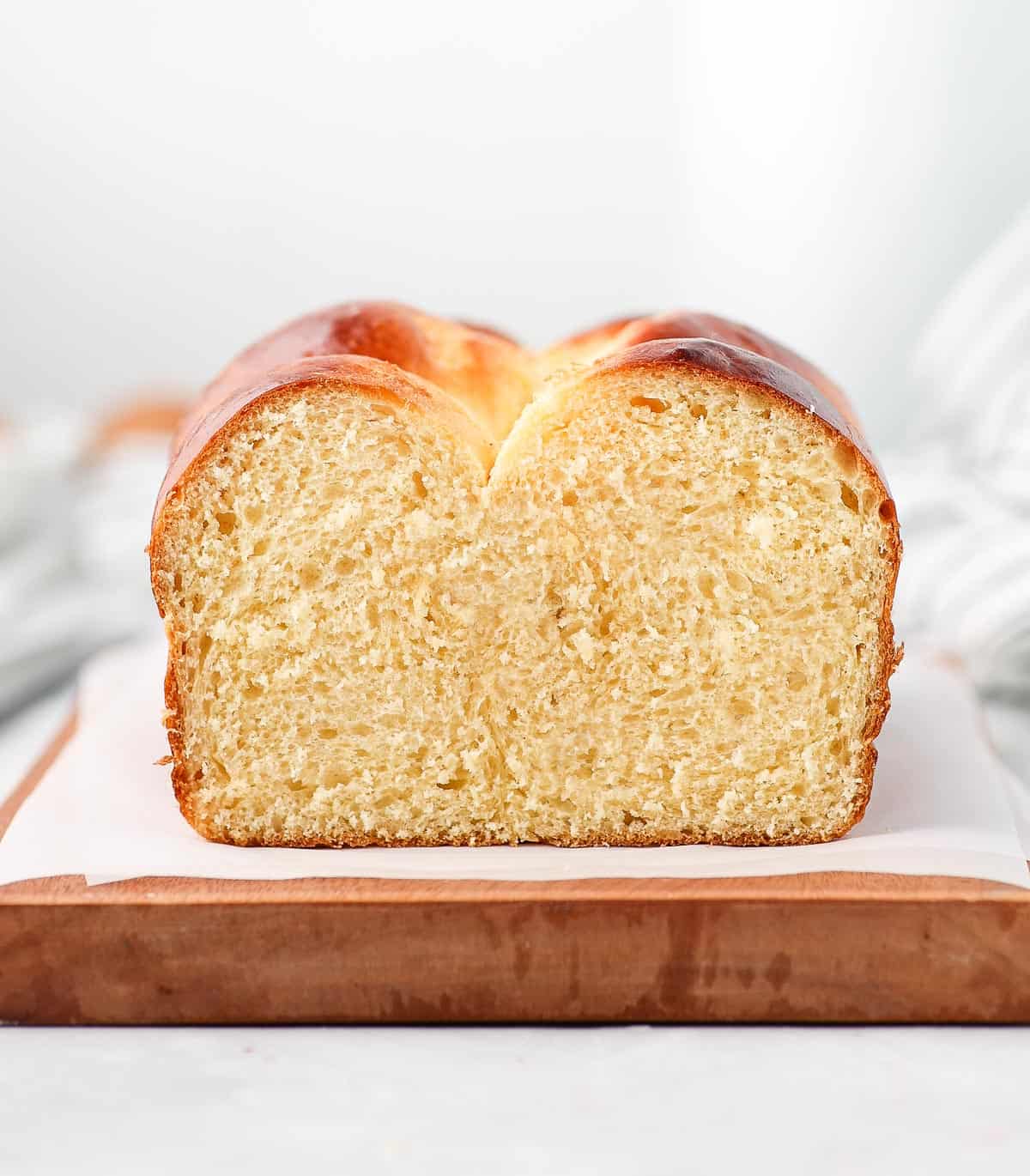
Made this recipe?
Let us know if you liked it by leaving a comment below, and tag us on Instagram @a.baking.journey with a photo of your creation!
Recipe
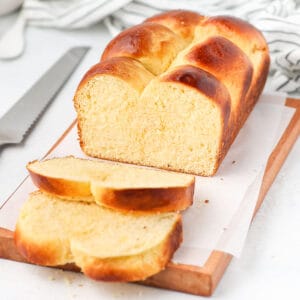
Brioche Loaf Bread
Ingredients
- 75 ml (5 tablespoons) Full Cream / Whole Milk - lukewarm
- 9 gr (1 1/2 teaspoon) Instant (dry) Yeast
- 80 gr (1/3 cup) Caster Sugar
- 3 Eggs - medium, at room temperature
- 350 gr (2 1/3 cup) Plain / All-Purpose Flour
- 1/2 teaspoon Fine Salt
- 120 gr (1/2 cup) Unsalted Butter - soft, at room temperature
- 1 Egg - for Egg Wash
Disclaimer
I highly recommend using the measurements in grams & ml (instead of cups & spoons) for more accuracy and better results.
Instructions
- Place the Lukewarm Milk, half of the Sugar and Yeast in the bowl of your stand mixer. Mix to combine then let it sit for about 10 minutes or until small bubbles/froth appears on the surface (see note 1).
- Add the whisked Eggs then the rest of the Sugar, Flour and lastly the Salt. Fit your mixer with the dough hook attachment and knead on medium speed for about 5 minutes or until a rough dough comes together.
- Add the soft unsalted Butter to the mixture, a little bit at the time. Knead on low speed until the butter is fully incorporated before adding more (see note 2).
- Knead on medium to high speed for about 15 to 20 minutes or until the dough is very soft, stretchy and passes the "windowpane test" (see note 3). Cover with plastic wrap or a tea towel and place in the fridge to proof for 8 to 12 hours (or up to 24 hours).
- Take the dough out of the fridge and punch out the air. Transfer over a lightly floured work surface and cut into 8 pieces, using a scale to measure even portions.
- Flatten each piece of dough with your fingers. Fold the edges of the dough towards the centre and press to make it stick. Turn the dough over, seams down, then pull it towards you, your fingers placed on one side / bottom of the roll. Turn it 90 degrees and repeat until you feel tension on the dough. Continue to shape the dough into a bun by rolling it in a circular movement under the palm or your hands. Repeat with each piece of dough.
- Place the buns in a 14 x 28 cm Loaf Pan (5.5 x 11 inch) Loaf Pan that has been lightly greased and lined with baking paper (see note 4).
- Lightly whisk an egg in a small bowl and brush it over the buns. Cover the pan and let the dough proof again at room temperature for about 1 to 1,5 hour, or until the buns have doubled in size.
- Preheat your oven on 180'C / 350'F then bake for 20 to 25 minutes or until risen and golden. Let the brioche loaf cool down for about an hour before removing from the pan and placing on a wire rack to finish cooling (see note 5).
Tried this recipe? Make sure to leave a comment and star rating below!
Notes
- Make sure the milk is not too hot or it will kill the yeast. It should be at around 30 to 35' celsius (85 to 95' F); if you touch it with your finger you shouldn't feel its warmth. Also note that "blooming" the yeast (what we are doing here) is not technically required when using Dry Yeast but it is mandatory if using instant yeast. This step is used to check that the yeast is alive before making the bread.
- If you add too much butter at once, the dough will struggle to incorporate it and it will turn quite greasy. Make sure to slowly add it to get the perfect smooth dough. It is also very important for the butter to best very soft and at the right temperature. If the butter is too warm, it will struggle to incorporated in the dough and you will notice the dough is very greasy. Place the bowl in the fridge for 5 minutes then keep kneading. If the dough is too cold, you will notice chunks of unmixed butter in the dough. Place the butter for a few seconds in the microwave or leave at room temperature for a bit longer.
- The dough does require a long kneading - much longer than most breads. That is because the dough is enriched with lots of fat (butter, eggs and milk) which slows down the gluten formation and development. Do not skip this long kneading step to get the perfectly fluffy brioche - it needs to be well kneaded!
To do the "windowpane test": gently pull and stretch a small piece of dough. If the dough breaks quickly, it needs to be kneaded for longer. If it stretches easily without breaking and you can see light coming through it, it has passed the windowpane test. - I placed the buns in 4 rows of 4, having 2 buns side by side. You could also place them in a zigzag pattern to create the effect of a braid (called a "Nantaise brioche").
- It is important not to cut the brioche when slice warm or it will turn dry. The residual heat will also finish cooking the bread and if you cut it too early, the steam will escape and the dough won't be fully baked.
Nutrition
French Brioche Loaf Bread Story.


